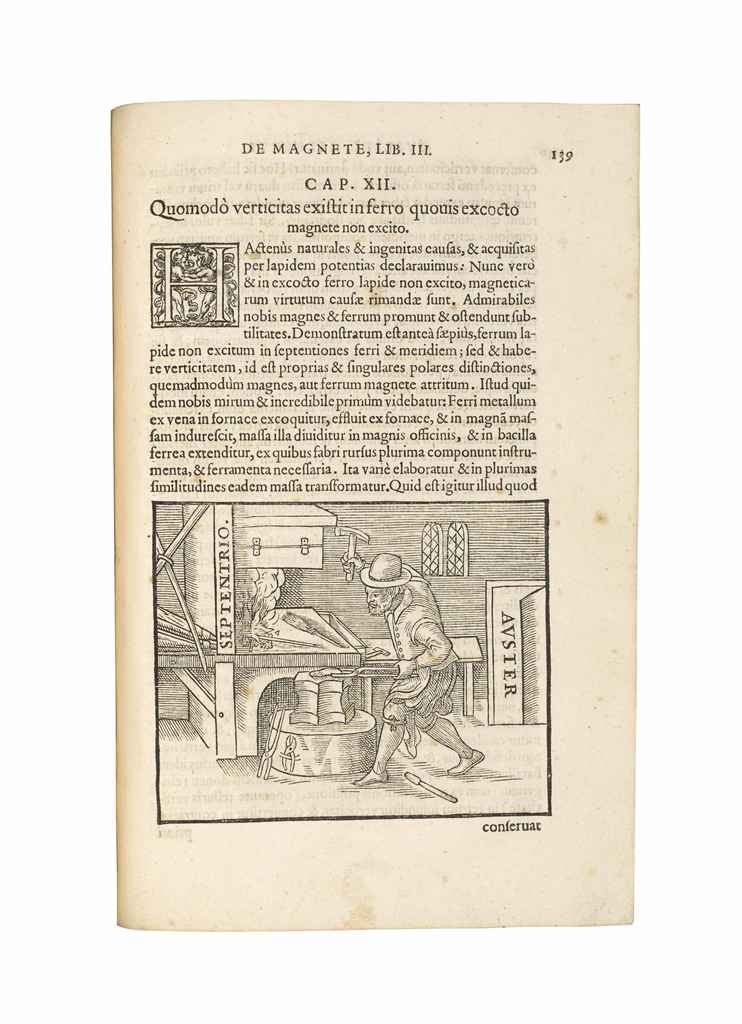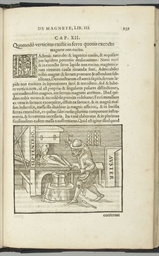GILBERT, William (1544-1603). De magnete, magneticisque corporibus, et de magno magnete tellure; Physiologia nova, plurimis & argumentis, & experimentis demonstrata. London: Peter Short, 1600.
GILBERT, William (1544-1603). De magnete, magneticisque corporibus, et de magno magnete tellure; Physiologia nova, plurimis & argumentis, & experimentis demonstrata. London: Peter Short, 1600. 2 o (271 x 186 mm). Woodcut caduceus device (McKerrow 119) on title-page, large woodcut arms on verso, numerous text woodcuts, some full-page, large folding woodcut diagram, woodcut historiated initials, head- and tailpieces. (Occasional light browning and staining, K1 and M5 with tiny holes affecting text.) Modern half vellum. Provenance : Princess of Lichtenstein (bookplate); purchased from Emil Offenbacher (n.d.) FIRST EDITION. Gilbert became the most distinguished scientist in England during the reign of Elizabeth I. His main work, De magnete , is "the first major English scientific treatise based on experimental methods of research. Gilbert was chiefly concerned with magnetism; but as a digression he discusses in his second book the attractive effect of amber (electrum), and thus may be regarded as the founder of electrical science. He coined the terms 'electricity,' 'electric force' and 'electric attraction'" (PMM). Book one "introduced his new basic idea... that the earth is a gigantic lodestone and thus has magnetic properties" and book two, with its observations on the amber effect, "introduced the vocabulary of electrics, and is the basis for Gilbert's place in the history of electricity" (DSB). His experiments concluded that a compass needle points north-south and dips downward due to the earth's magnetic force. Dibner Heralds of Science 54; Grolier/Horblit 41; J. L. Heilbron, Electricity in the 17th and 18th centuries (Berkeley, 1979), pp. 169-179; Norman 905; PMM 107; STC 11883; Wellcome 2830.
GILBERT, William (1544-1603). De magnete, magneticisque corporibus, et de magno magnete tellure; Physiologia nova, plurimis & argumentis, & experimentis demonstrata. London: Peter Short, 1600.
GILBERT, William (1544-1603). De magnete, magneticisque corporibus, et de magno magnete tellure; Physiologia nova, plurimis & argumentis, & experimentis demonstrata. London: Peter Short, 1600. 2 o (271 x 186 mm). Woodcut caduceus device (McKerrow 119) on title-page, large woodcut arms on verso, numerous text woodcuts, some full-page, large folding woodcut diagram, woodcut historiated initials, head- and tailpieces. (Occasional light browning and staining, K1 and M5 with tiny holes affecting text.) Modern half vellum. Provenance : Princess of Lichtenstein (bookplate); purchased from Emil Offenbacher (n.d.) FIRST EDITION. Gilbert became the most distinguished scientist in England during the reign of Elizabeth I. His main work, De magnete , is "the first major English scientific treatise based on experimental methods of research. Gilbert was chiefly concerned with magnetism; but as a digression he discusses in his second book the attractive effect of amber (electrum), and thus may be regarded as the founder of electrical science. He coined the terms 'electricity,' 'electric force' and 'electric attraction'" (PMM). Book one "introduced his new basic idea... that the earth is a gigantic lodestone and thus has magnetic properties" and book two, with its observations on the amber effect, "introduced the vocabulary of electrics, and is the basis for Gilbert's place in the history of electricity" (DSB). His experiments concluded that a compass needle points north-south and dips downward due to the earth's magnetic force. Dibner Heralds of Science 54; Grolier/Horblit 41; J. L. Heilbron, Electricity in the 17th and 18th centuries (Berkeley, 1979), pp. 169-179; Norman 905; PMM 107; STC 11883; Wellcome 2830.




.jpg)



.jpg)

.jpg?height=400)


.jpg)
Testen Sie LotSearch und seine Premium-Features 7 Tage - ohne Kosten!
Lassen Sie sich automatisch über neue Objekte in kommenden Auktionen benachrichtigen.
Suchauftrag anlegen